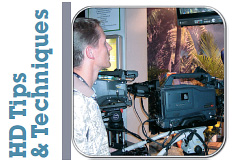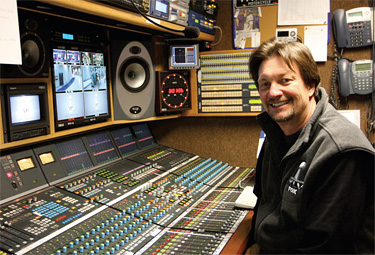5.1 Surround: Creating An Illusion of Space

NEW YORK—For televised sporting events, a successful surround sound mix reproduced on a good playback system gives viewers an exciting aural experience they couldn't get elsewhere, not even if they were in actual attendance.
Surround sound mixing is about creating an illusion of space. And with the increasing HD/5.1 sports productions over the past few years, sports sound mixers have developed effective techniques to provide a very realistic illusion.
Here are some 5.1 tips and techniques from one of the leading sports audio mixers, Fred Aldous, Fox Sports Audio Consultant/Senior Mixer. Aldous primarily mixes NFL football, and NASCAR auto racing events, but you may find him mixing baseball and other sports as well.
INDEPEPENDENT MICS & SINGLE POINT 5.1 MICS
Regardless of the type of sport, Aldous captures the sound field with strategically placed independent microphones, or pairs of microphones, rather than using single point 5.1 microphones. His experience has shown that there are many advantages to this approach.
Picking up and blending sound sources from different areas of an arena, stadium, or track allows Aldous to create a bigger and fuller crowd sound. In contrast, a 5.1 single point mic picks up sound from one particular location only. Even though such a mic provides directional outputs, it's of a more homogenous sound field.
Aldous has more flexibility in manipulating the outputs from independent microphones, for levels, spatial positioning, or effects, than he would with a single point 5.1 mic. And he's found that he gets a better left-right stereo downmix with independent mics as well. "You don't have to worry about phase issues [with independent mics]," Aldous said. "With single point mics, you can get flanging as the sound folds down on itself."

Fred Aldous, Fox Sports Audio Consultant/Senior MixerSURROUND PERSPECTIVE
Aldous considers the point of view or surround perspective that he creates for each type of sport. As auto racing and football are inherently different kinds of sports, so too is Aldous's mixing philosophy for each of them.
For NFL, the playing field is stationary and in front of a viewer, so here Aldous puts the viewer in the position of an observer in the stands, surrounded by crowd noise.
For NASCAR, Aldous mixes from a point of view perspective. Here he puts the viewer where the cameras are, spaced around the track, and creates the spatial impression of the cars speeding past the viewer at 180 mph. "We give racing viewers something they never heard before," Aldous said. Microphones are placed along the wall of the track, near the cameras and synchronized to the pictures.
At each camera location, Aldous mixes only three or four omnidirectional mics to create its soundscape. There are three microphone positions—the first approximately 30 to 45 feet in front of the camera, the second about 15 feet in front of the camera center, and the third at the right rear at the camera position itself. This last mic position is used to fill in front to rear as the car moves from left to right.
Omnis are perfect for this job as they are placed relatively close to the track, and the sound of the cars is so loud. Aldous said he doesn't need a lot of reach, the kind that a hypercardioid shotgun would give. "There are neat reflections coming off the wall and the grandstand, so the omni works well with that scenario."
Aldous mixes these mics to give the spatial experience of the cars zooming past the viewer right in their living room, from the upper left to the rear right.
NFL MIX
For NFL, Aldous's mix perspective is based on a viewer or participant in the stands, with the 5.1 crowd bed always behind the viewer, and with stereo field effects in front.
To capture the crowd in surround, Aldous uses three sets of stereo mic pairs—one out in front of the announce booth, another at the near side of the field, and a third at the far side. The pair in front of the announce booth is a wide A-B split, where the mics are spaced at some distance from each other. Each of the two side pairs are set in an X-Y configuration, where a pair of cardioid microphones are angled toward each other so that the capsules are coincident.
The effects mics on the field consist of parabola mics and the shotgun mics mounted on handheld cameras. Aldous leaves these panned left and right in front, and run through a stereo synthesizer. He cautions careful use of the synthesizer to get a good spatial effect without getting squirrely sounding artifacts.
MORE ACCESS?
As much as 5.1 techniques have been worked out, there's always room for more audio excitement. Aldous would love to get more access, with mics on players or pit crews.
If it was somehow physically possible, he would even like to try a 5.1 mic hanging over a basketball court or auto race track, to get a balanced 360 degree perspective.
But in the meantime, it is hoped that the tips and techniques that Aldous shared would provide some good ideas to those newer to 5.1 surround mixing.
Mary C. Gruszka is a systems design engineer, project manager, consultant and writer based in the New York metro area.
The professional video industry's #1 source for news, trends and product and tech information. Sign up below.
